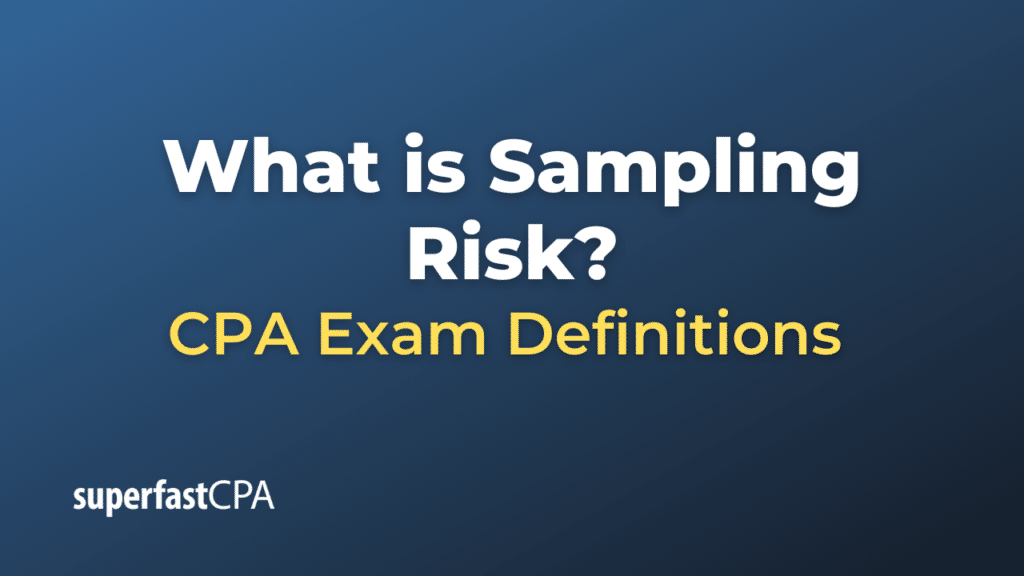Sampling Risk
Sampling risk refers to the possibility that the conclusions drawn from a sample might not accurately reflect the conclusions that would be drawn from the entire population. It’s a concept often used in the context of auditing, statistical testing, and other disciplines where drawing conclusions based on a subset (sample) of data is common.
There are two main types of sampling risks:
- Risk of Incorrect Acceptance: This is the risk that the auditor concludes that a batch of financial statements is correct when, in fact, there’s a material misstatement. For example, an auditor may test a sample of transactions to see if they’re correctly recorded. If the sample doesn’t contain any errors, the auditor might conclude that all transactions are correct, even if errors exist in the transactions not included in the sample.
- Risk of Incorrect Rejection: This is the risk that the auditor wrongly concludes that there’s a material misstatement in the financial statements when they are, in fact, correct. For instance, if an auditor tests a sample of transactions and finds an error, they might conclude that the whole batch of transactions contains errors, even if the error was limited only to the sampled items.
In both scenarios, the conclusions drawn from the sample do not accurately represent the entire population or dataset.
To manage sampling risk:
- Increase the Sample Size: Generally, the larger the sample size, the lower the sampling risk, as the sample is more representative of the population.
- Use Appropriate Sampling Techniques: Depending on the type of data and the purpose of the analysis, different sampling methods (like random sampling, stratified sampling, or cluster sampling) can be more suitable.
- Consider the Desired Confidence Level: When making decisions based on samples, auditors, researchers, or analysts often use confidence intervals to quantify the level of uncertainty in their estimates. A higher confidence level generally requires a larger sample size but provides greater assurance that the sample estimate is close to the population parameter.
In auditing specifically, managing sampling risk is crucial to ensuring that auditors provide accurate and reliable opinions on financial statements. If sampling risk is too high, the conclusions drawn from audit procedures may not be trustworthy, potentially leading to incorrect audit opinions.
Example of Sampling Risk
Let’s illustrate the concept of sampling risk with a practical example related to quality control in a manufacturing setting.
Scenario: Toy Factory Quality Control
Imagine you run a toy factory that produces thousands of toy cars every day. Each toy car should be painted blue, and it’s crucial that the paint job is consistent and free of defects.
Goal: Ensure that 99% of the toy cars produced daily meet the quality standard.
Procedure: Since inspecting every single toy car would be time-consuming and inefficient, you decide to randomly select 100 toy cars each day as a sample to check for paint defects.
Day 1 Results: Out of the 100 toy cars sampled, 3 have paint defects. This suggests a defect rate of 3%.
Sampling Risks:
- Risk of Incorrect Acceptance: Let’s say that the actual defect rate for all toy cars produced on Day 1 is 5%, but by chance, the sample only captured a 3% defect rate. This means you incorrectly accept the notion that the defect rate is below the 1% limit when, in reality, it’s not. The consequence might be that more defective products end up in the market than acceptable.
- Risk of Incorrect Rejection: Imagine on another day, the actual defect rate for the entire production is 0.5%, but the 100 toy cars you sampled had 2 defective cars, suggesting a 2% defect rate. Based on this sample, you might think there’s a problem in the production line and perhaps halt production to investigate, wasting time and resources, when in fact, the production process is performing better than the standard.
Mitigating Sampling Risk:
To reduce the risk:
- Increase Sample Size: Instead of checking 100 toy cars, you could check 300. A larger sample might give a more accurate representation of the entire production lot for that day.
- Stratified Sampling: If cars are produced in different sections or batches, ensure that the sample includes cars from all sections or batches to get a more comprehensive view.
- Continuous Monitoring: Perhaps use automated systems to continuously monitor and provide real-time feedback, ensuring that samples are consistently representative.
In conclusion, while sampling is an effective method to draw inferences about a larger population or batch, there’s always the risk that the sample might not accurately represent the whole. Understanding and managing this sampling risk is crucial to making informed decisions based on the sample results.













